The question of how you can bend fittings not only in production, but also at home, interests many of those who are independently engaged in construction on their personal plot. The relevance of this issue is due to the fact that the reliability and durability of buildings and concrete structures for any purpose largely depend on the correctness of this process.
Why is it necessary to bend the reinforcement and how best to do it
As you know, concrete structures do not tolerate bending loads poorly, under the influence of which they begin to collapse. To avoid such negative consequences, concrete structures are strengthened with frames made of steel rods, and recently they began to use for the same purposes composite rebar... Without a reinforcing frame, it is almost impossible to make a reliable foundation for any structure, as well as concrete structures that experience mechanical stress during operation.
The weakest points in any reinforcing cage are the joints of the bars, which is especially important for corner joints, the creation of which by crossing straight reinforcing bars is a serious violation of technology.
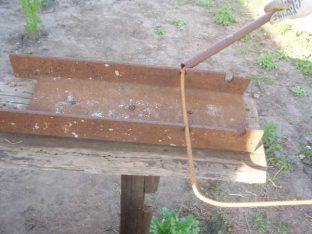
Corner sections of the reinforcement cage, formed in this way, significantly weaken the concrete structure and can lead to delamination. That is why for such connections, it is necessary to bend and lay the reinforcement in such a way that an overlap of at least 80 cm is formed on each bar adjacent to it. the effect of tensile loads (hooks for various purposes, legs, etc.).
Only experts know how to bend the reinforcement so that it does not lose its initial strength characteristics. It is important to keep in mind that with your own hands it is allowed to bend only metal fittings, but not from composite materials (information on how to cut fiberglass reinforcement, can be found at the end of the article).
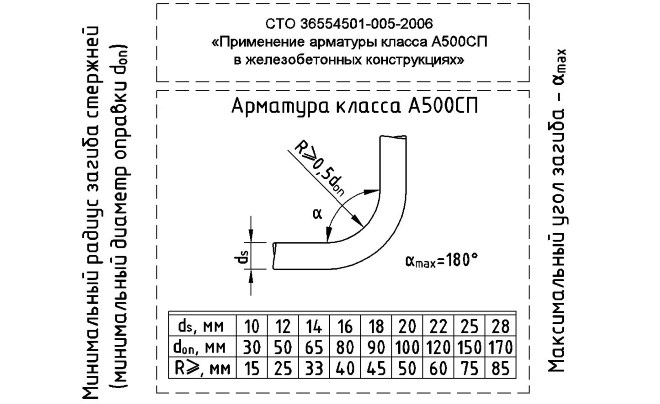
To obtain a reliable framework for the foundation, it should be carried out only mechanically, avoiding the formation sharp corners at the bend. The radius of curvature of the rods, which is formed in the place of bending, should have a value in the range of 10–15 diameters of the product itself.
Those who do-it-yourself bending of reinforcement often make the following blunders:
- make a cut or an incision at the bend in order to facilitate their work (such an incision, disrupting the structure of the metal bar, significantly weakens the frame structure);
- the place where it is necessary to perform the bend is preheated with a blowtorch or by placing the rod in a fire.
After making an incision or heating a bar at home, it is usually bent with the help of improvised means - a sledgehammer, a hammer, a piece of pipe, etc. Naturally, all such procedures lead to the weakening and destruction of the reinforcement structure. To preserve its strength characteristics, it is necessary to bend the elements of which it consists only in a cold state and without violating the integrity of their structure, if this is not additionally specified in the design documentation.
Devices for bending reinforcing bars
A lot of devices and simple machines that allow you to bend any reinforcement with your own hands have been invented. All such devices work on a similar principle, and their differences are in design and technical characteristics, the most significant of which is the largest diameter of the bent bar.
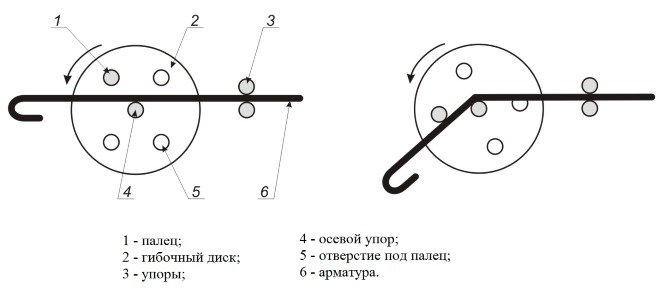
The armature to be bent is fixed on such a machine between two rollers: a central one and a thrust one. The bending process itself is carried out due to the impact on the bar of the third roller, which is called: bending. By acting on the bar during bending (it can be performed both clockwise and in the opposite direction), the bending roller allows you to obtain the required bending angle on the product. A thrust roller or shaft performs a limiting function, thanks to which the reinforcement is not deformed along its entire length, but only in the place where it is required to form a bend.
Today, two categories of such machines are used:
- manually operated devices;
- models with a mechanical drive.
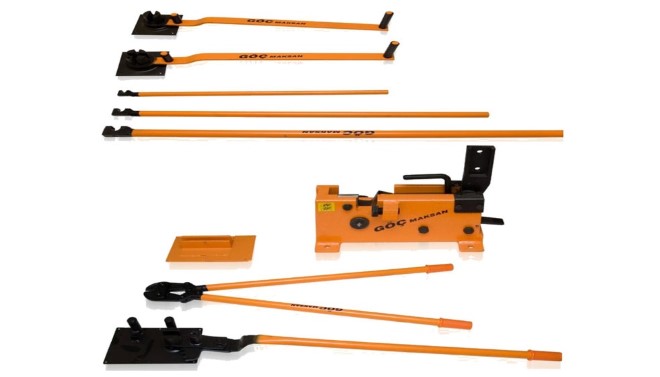
The structural diagram of the machines equipped with a mechanical drive is as follows. A disk is mounted on the shaft of the device, located vertically, on the surface of which the central and bending fingers are fixed. The roller, against which the reinforcing bar rests during the bending process, is fixed on the machine stand. Reinforcement using such a machine is bent according to the following scheme: the bar is placed between the central and bending fingers; when the disk rotates in the horizontal plane, the bar rests against the thrust roller and, under the influence of the bending pin, begins to bend around the central roller. The bending pin during bending moves along the outside of the bend being formed.
The machines, the design of which is described above, may differ from each other in their power and performance, and according to their purpose, they are divided into three main categories:
- models for bending light fittings with a diameter of 3–20 mm;
- devices for working with heavy fittings (20–40 mm);
- models for bending super-heavy reinforcing bars (40–90 mm).
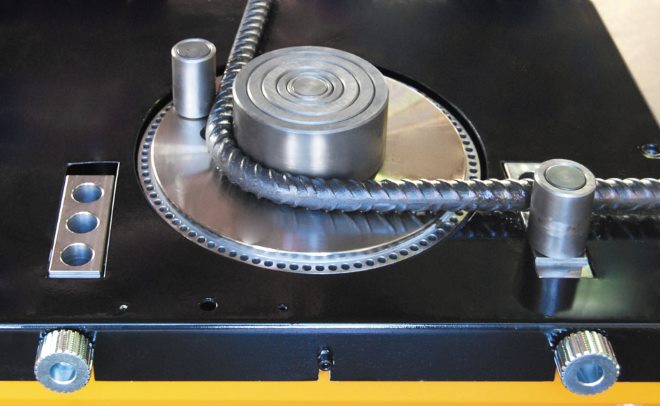
On machines belonging to the latter category, several reinforcing bars can be bent at the same time. On the modern market, you can also find universal equipment, the technical capabilities of which make it possible to bend metal bars in the range of diameters 3–90 mm. If desired, you can find a device with a hydraulic drive, with the help of which complex reinforcement structures with variable bending angles are obtained and even a ring is formed from a metal bar.
The use of such equipment allows you to make very high-quality bends, the angle of which can reach 180 degrees. The surfaces of the workpieces that have been bent on such equipment do not have folds and breaks, and there is no metal stress in their internal structure.
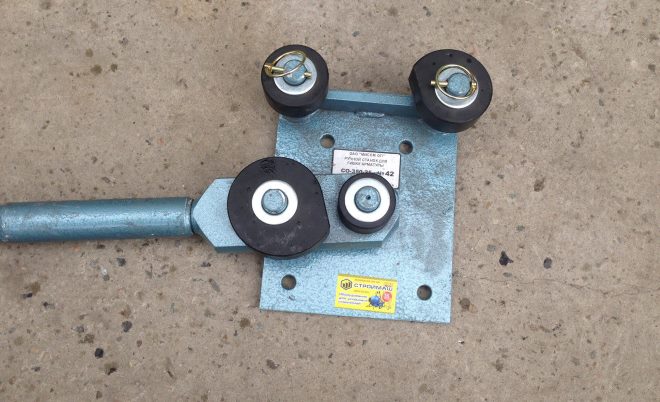
In a fairly large assortment, manual ones are also presented on the market, among which there are both portable and more overall models. To bend fittings at home, you can purchase both a specialized handheld device and a pipe bender. Such simple devices that allow performing various bends of reinforcing bars, the diameter of which does not exceed 14 mm, are mounted on the surface of a work table or workbench. For equipping a home workshop, this option is quite suitable, but if it is necessary to carry out large amounts of work on bending reinforcement, it is better to purchase a more serious machine.
The choice of equipment with which the reinforcement can be bent at home is mainly influenced by two factors: the diameter of the rods and the amount of work that you need to perform. When bending, various parts of the reinforcing bar are subjected to loads of different directions: the outer surface of the bend is stretched, the inner one is compressed. Such loads, if incorrectly selected and set up the machine, can lead not only to the appearance of defects on the surface of the bar (kinks and folds), but also to its destruction. That is why you should choose a bending machine taking into account all the characteristics of the reinforcement that will be processed on it, and the parameters of the bends being formed. The correct setting of the machine is also of great importance for making good bending of the reinforcement.
How to make a device for bending fittings with your own hands
Focusing on the drawings of serial bending machines, as well as on numerous videos on the Internet, you can make such a device with your own hands. You simply cannot do without such a device if you are going to make a reliable reinforcing frame to strengthen the foundation of your future home and buildings for other purposes.
![]()
The elements of a home-made machine for bending fittings are a metal frame, to the surface of which a thrust pin is welded (you can use a regular corner), and a metal turntable, controlled by a lever (the central and bending pins are fixed on its surface). The choice of the size of such a device, as well as the distance between its elements, is influenced by the diameter of the rods that you are going to bend on it. You can attach this device either to the surface of the workbench using bolted connections, or to the floor of the workshop, but for this the machine must be equipped with legs.
The easiest ways to bend reinforcing bars
When reinforcing the foundation of small buildings, it is not always advisable to make special devices that allow you to bend reinforcement for it. In cases where the future structure, the reinforcement of the foundation of which you are going to perform, will not exert serious loads on the base, you can do without bending devices.
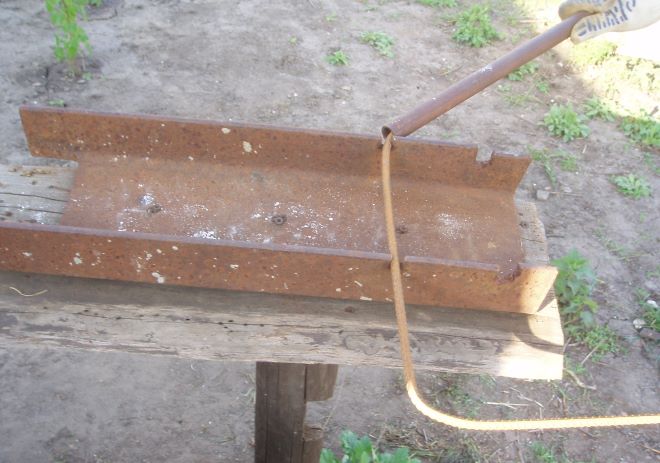
Metal rods, the diameter of which does not exceed 8 mm, can be bent with your own hands, this is not particularly difficult. True, in such cases it is not necessary to count on a high-quality bend. A more successful bend is obtained using two pipes, one of which acts as a lever, and the other as a stop element. The pipe, acting as a thrust element, can be clamped in a vice, buried or even concreted in the ground. You can learn how to bend any reinforcement without special devices from numerous videos on the Internet.
Reinforcement in construction is necessary, first of all, for concrete reinforcement. Such a connection allows the transfer of compressive and tensile forces to the reinforcing bars. This is simply necessary when building a foundation, since concrete has little resistance to such loads.
|
Armature |
It is not correct to reinforce with connections from straight rods, this weakens the structure, which can lead to various unpleasant consequences, for example, to the stratification of the foundation.
Therefore, the bending of the reinforcement is necessary both for creating angular bundles of curved rods and for creating various elements, for example, a foot, a hook, etc.
Fiberglass rods can be bent only at their production facilities. If you try to bend it with your own strength, then it will simply burst. Metal fittings are bent strictly mechanically; no sharp corners should be allowed at the bending point.
There are still several popular methods that are not desirable for bending rods. It:
- Notched angle grinder of the fold
- Warming up the bend to a high temperature with a blowtorch, etc.
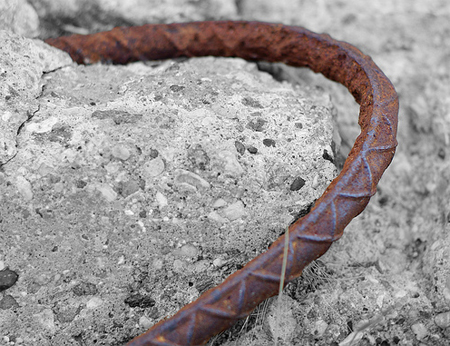
Bent reinforcement in concrete.
Any type of metal rods bends only cold without any cuts or other damage to the integrity of the rod. Moreover, each type can be bent to a certain angle, after which it will lose strength. For example, reinforcement of type A3 can be bent to an angle of no more than 90 degrees without loss of strength. When bent 180 degrees, the strength decreases by at least 10%.
All equipment for rebar bending can be divided into several categories
th- Manual
- With a mechanical drive.
- Hydraulic
Driven equipment operates as follows
A thrust roller is fixed on the rack, a disk is installed on the vertical shaft, on which the fingers (bending and central) are fixed. Bending rods are placed between them. When the disc begins to rotate in the horizontal plane, the laid rod abuts against the roller and bends under the influence of the bending pin. The flexor finger moves from the outside of the bar.
Bending machines, depending on the rods, are also divided into equipment:
- For bending with rods from 3 to 20 mm.
- For bending rods from 20 to 40 mm.
- For bending rods from 40 to 90 mm.
- For bending rods from 3 to 90 mm.
Manual bending equipment has many types, it can even be portable. Usually installed on a workbench for easier handling. Much cheaper than other options and completely easy to use. The tool is suitable for small amounts of work.
Before buying a tool, be sure to know the scope of work, timing and diameter of the rods to be bent. In addition, it must be remembered that the outer part of the reinforcement is more susceptible to tensile stress and the inner one to compression.
If you choose the wrong equipment or use it not according to the instructions, you can easily spoil both the fittings and the machine. Therefore, before use, the structure should be correctly adjusted and, during use, the reinforcing bar should be correctly clamped in it.
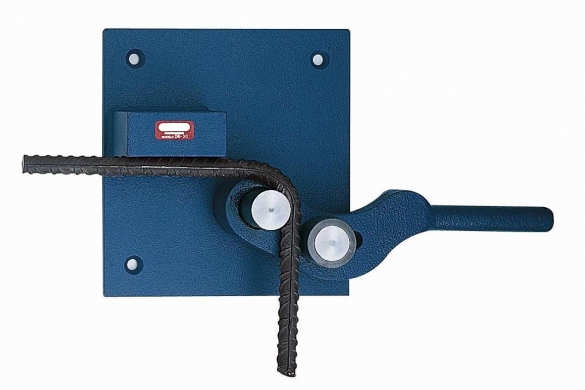
One of the rebar bending devices
When special accuracy and precision is not required, thenyou can even bend the rods with your own hands. With strong hands and a rod with a diameter of 8 mm is not a problem.
Two steel pipes will facilitate the process and improve the bending quality. The longer the pipes, the larger the diameter of the rod can be bent.
The process itself is quite simple:
- The rod is inserted into the first fixing pipe up to the bend point.
- The second pipe will be used as a lever. it is put on the other end of the armature and is guided in the desired direction.
- The armature is bent.
Modification is also possible when both pipes are firmly buried or driven into the ground. The rod is wound between the pipes and bent into the desired position.
An example of a homemade rebar bending machine
Manual rebar bending machine:
The armature bending machine is a necessary device used during construction as well as industrial work.
With its help, in the future, it is really possible to manufacture both reinforced concrete and metal structures.
There are times when you can do it on your own, but most often the thickness of the products is so large that it is possible to achieve bending only with the help of special devices.
The modified rebar bending machine allows not only shaping sheets and other materials, but also cutting them.
Also, many devices make it possible to make rings, fastening clamps and parts, hinges from wire, pipes or other raw materials, which are used in installation and at construction sites.
Despite the complexity of the design, the machine can be designed and assembled by hand. To do this, you will need a prepared drawing, tools and knowledge of the principles of the device.
For domestic purposes, a home-made manual bending machine for rebar is used primarily in the construction of the foundation.
It is almost impossible to make a reliable base without reinforcing parts, so the question arises - how to make a frame, how to bend the existing reinforcement?
Of course, today on the market you can find a huge selection of professional equipment, but the price for it can be very high.
Such devices are bought for industrial purposes, the arrangement of workshops, construction firms. For your personal purposes, a self-assembled structure is suitable.
If we talk about technological standards, then the machine for bending fittings must have three shafts.
One of them is persistent (holds the rods at a certain angle and fixes them), the second serves to bend the material around the main shaft - the third. It is also called central.
Depending on the type of construction, mechanical is also distinguished.
The latter is widely used in everyday life, because it is compact in size and relatively low cost, and due to its simplicity, everyone can work on it.
There are also hydraulic or pneumatic devices. Thus, the hydraulic rebar bending machine can bend the material up to 180 degrees, ensuring no breakage.
When designing with your own hands, you must not only adhere to your project, but also pay special attention to the quality of the fasteners (after all, the load on the parts is very high), and take care of the organization of protection.
A slipped rod can cause serious injury.
Therefore, often on the simplest bending machines for reinforcement, you can find plexiglass protection, which you can easily do yourself.
Also, if you have experience in assembling machine tools, then you can provide your design with speed switching to regulate work.
Some models are equipped with a foot panel that allows you to easily change the direction of flow of the valve.
How to make a home machine?
In order to cope with a manual bending machine for rebar with your own hands, you must first prepare a number of tools.
If you are fond of assembly and construction, then finding such parts and the necessary equipment will not be difficult.
First of all, you need electric welding. For a device that can handle even sheets, you need a reliable base, punch, clamps and clamp.
1 - bending disk, fixed on a vertical shaft; 2 - finger; 3 - finger hole; 4 - stops; 5 - reinforcing bar; 6 - axial stop
The punch can still be assembled from metal corners. Suitable for assembling and cutting channels.
The base is cut precisely thanks to the latter.
The fifth or sixth model number of the channel is suitable here. But the length should be chosen small - no more than 50 centimeters.
The rebar bending machine will consist of a lever, a punch, a clamp and a main part on which pipes and rods or sheets will be located.
First, on the basis of the selected place, an axis for the clamps is made - it will be more convenient to navigate along it.
Keep in mind, however, that the clamps should cut 6 millimeters less than the blanks made under the base.
They also keep at a distance of several centimeters from the ends - without such an indent, it will be impossible to correctly distribute the load.
A wire is suitable for the lever, the diameter of which should be no more than 15 millimeters.
The base is bent in the form of the letter "P", and it is welded using welding machine to one of the stable corners. There should be an indentation of about 5 millimeters from the edge.
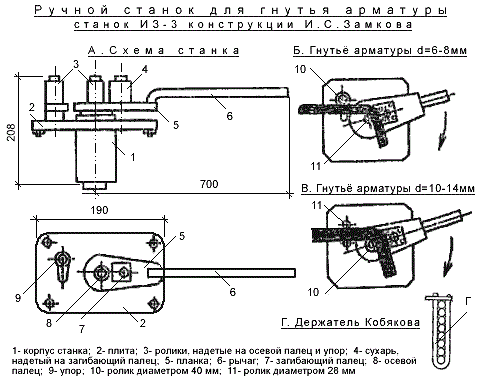
In order to properly weld all the parts and check the corners, the evenness of the structure, and the joining, you can first use a vice, and then welding on them.
Thus, it will turn out to make a preliminary frame, which can always be redone.
Also, where possible, it is better to use bolts instead of welding. So it will always be possible to reassemble or disassemble your structure, to supplement it with details.
If, however, preference is given to welding, then first a test bending procedure must be carried out. If all stages go well, then you can weld the parts together.
How to add elements for cutting?
In addition to the fact that on a home-made device you can give various shapes to products, it is really possible to make a machine for cutting reinforcement, which will combine both functions: cutting and bending.
Of course, it is much more difficult to design it with your own hands, but it also has more applications. The easiest option is to make a carved disk on the basis using a grinder.
The rebar cutting machine can be made in any room. Its design can be either collapsible or one-piece.
In the first case, such a device can be easily dismantled and assembled at a new place.
Structurally speaking, in addition to the shafts for bending, the rebar shearing machine should consist of an engine, a cutting blade or disc and the surface itself where the blade will be fixed.
Knowing the principle of operation, you can easily make your own changes to the feeding mode.
The power must be determined in advance, before the rebar cutter is assembled.
Professional devices are distinguished by high powers - about 2000 W.
Despite the fact that for household purposes, you can choose smaller indicators, do not forget that metal remains metal in any situation, and a large load is needed to cut it.
Another characteristic directly related to engine power is gear selection.
Most often this is a belt or friction transmission of friction. In this case, the engagement can be chain, worm or gear, it all depends on what materials you have at hand.
Belts provide quiet operation, however, the likelihood that such a structure will slip off is very high, so it is better not to choose this type of transmission.
The homemade rebar cutting machine also comes with a vice that prevents material from exiting the cutting axis.
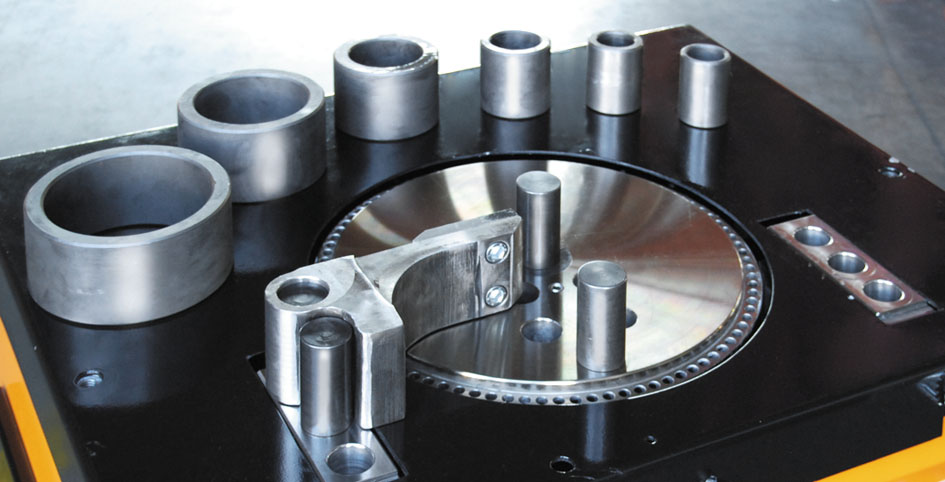
As a knife at home, either a carbide disc or an abrasive wheel is most often chosen. The type of device depends on the tool feed.
It can have frontal, bottom or pendulum feed.
The assembly principle is very similar to the bending design. So, a machine for cutting reinforcement begins to be made from a frame, which in turn is assembled from metal corners.
It is necessary to attach a channel to the resulting base, which will play the role of a guiding axis, and all other parts are attached to it.
Only the engine needs an additional reinforced pipe.
The bearings, which are needed to support and propel the machine, are attached to the upper frame, and the shaft and motor are bolted on.
In addition, where the disc will be fixed (also with the help of bolts), you need to take care of the protective case, because if it comes into contact with the metal, a spark will arise.
It is better to check the work on the machine at idle speed and using soft metals. Later, if everything is working properly, you can check the installation in full force.
The main thing is that the distance from the bending shaft and the disk is at least 40 centimeters.
When creating a structural frame for concrete work, it is very often necessary to bend and cut reinforcement (steel rods to harden the concrete). It is an easy-to-work material that is often used in landscaping, art and other projects where bendable metal is required. Conventional reinforcement has a nominal diameter that varies in 1/8 "increments (that is," number 4 "reinforcement has a 1/2" (15 mm) nominal diameter). Rebar up to number 4 can generally be bent and cut by hand. Larger diameters are usually not used except for technical or industrial concrete work and usually require special equipment such as hydraulic shears and bending machines.
In this article we will assume that 1/2 inch rebar (number 4) is used, which is common and used in landscaping and concrete works residential areas.
- Sharp bends almost always require the use of a vise, template or special tool.
- It is possible to heat the armature with a torch for precise control of the bending process. However, this is unlikely to be necessary when working with reinforcement having a nominal diameter of 1/2 inch (15 mm).
Warnings
- Cutting reinforcement, especially with an abrasive cut-off wheel, creates very hot sparks. These sparks ignite bare skin and are very harmful to the eyes. Whenever you cut any type of steel, wear a shirt with long sleeves, gloves and goggles.
- Using heat to make the reinforcement easier to bend can weaken it significantly.
- The fittings are often rusty. If you cut yourself while working with any rusty metal, you may need a tetanus shot. See a doctor.
If you started to erect new house, then, to strengthen concrete foundation you will need to make a reinforced frame. Reinforcing rod is produced, like any rolled metal, exclusively in direct form... But in order to make a frame from reinforcement, it must be bent in a certain way. Moreover, this operation will have to be performed directly at the construction site. There is only one rational way out - this is to make a do-it-yourself machine for bending fittings.
The time and money spent on a homemade rebar bending machine will pay off even at the stage of building the foundation of your house. It can also be used in the future. For example, for the manufacture of embedded parts such as window or door lintels. But even after that, he will be useful to you more than once for the assembly of various steel structures.
Bending of a reinforcing bar is a process of controlled reversal of the direction of the central axis. In this case, in the place of deformation, some layers of metal will stretch, while others will shrink.
One of the main determining factors in flexion is the amount of force applied to the deformation site. It directly depends on the type of steel and the diameter of the section of the reinforcement. Thus, you can immediately decide that the better and thicker the reinforcing bar, the more forces you need to apply to bend it.
These definitions should serve as the basis for further calculations in the manufacture of a device for bending reinforcement with our own hands.
How to bend reinforcement without a special device
Still, let's start with the fact that you urgently need to bend a small amount of a thin metal bar. To do this, we will analyze several ways how to bend reinforcement using available tools.
It is worth knowing here that when trying to bend, especially alloyed reinforcement, you need to consciously calculate your actions with your own hands, otherwise it can lead to serious injuries. Alloyed metal rolling, when trying to deform it, will try to spring in every possible way and is capable of causing irreparable harm to your health. So be careful and attentive.
Let's highlight the three most easy wayshow to bend reinforcement with a diameter of up to 8 mm on your own without the use of special devices, namely:
- With two pieces of metal pipe. So, we need tubes with a diameter of 15 mm with a length of 0.5 and 1 meter, which we put on the reinforcement. We become feet on a half-meter piece of pipe, and a meter-long piece, respectively, we begin to raise to the bend angle we need.

- If a five-centimeter piece of pipe 25-32 mm in diameter is welded to a one and a half meter metal pipe of 32 diameter or 50 mm, a steel angle is welded by means of electric welding, then you get a universal bending arm. All that remains is either to stand on the reinforcement, or to rest it against something solid.
- Not very long pieces of rebar can be bent with a large vise and a sledgehammer. Only with this method you should not rush and you need to beat with little effort, stretching the process, otherwise you can simply break the reinforcing bar.
The main disadvantage of using such methods for bending reinforcement is that the turning radius turns out to be quite large and often the angle turns out to be somewhat curved and does not lie with its sides strictly in the same plane.
Although, with good physical data and small diameters of a metal bar, these methods, as a rule, in practice are the most versatile rebar bending at home.
How to make a fixture for rebar bending
If, nevertheless, the volume of work is large and you have enough technical knowledge, then it is quite within the power of everyone to make a manual bending machine for reinforcement with your own hands, therefore, it is all the more not worth buying it on the construction market.
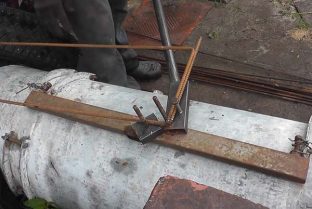
Option of armature bender from available tools
Before you start manufacturing, you need to complete detailed drawings of the units of the future device. To do this, it is recommended that you familiarize yourself on the Internet with ready-made samples made according to the standard scheme or choose some other technique than bending reinforcement.
A simple do-it-yourself armature bender is easiest to perform, based on the general principle of operation of such devices, namely, consisting of three main parts:
- massive base,
- a swivel mechanism in the form of a large lever,
- strong stop.
To make such a device, the materials and tools available in any normal garage are quite suitable. So, let's prepare the necessary tools for this, here we need:
- angle grinder with cut-off wheels and grinding disc,
- electric drill with a set of drills for metal,
- electric welding machine with electrodes,
- standard set of hand locksmith tools.
Although the preparation of component parts and assemblies is an important step, here we will try to adapt various materials at hand. In extreme cases, the missing item can be borrowed either from a neighbor or bought in addition on the construction market.
Sequencing
- We make the foundation. To do this, we take a sheet metal 3-5 mm thick with dimensions of 100 by 200 mm, or you can take a piece of channel 10-15 dimensions with a length of 200-300 mm.
We drill holes in the corners of the base for the possibility of attaching to a workbench or other massive object. In the center of the structure, an axial stop is firmly welded using electric welding. It is a steel shaft 50 mm high and 14 mm in diameter. For this part, you can take any suitable size M14 bolt, from which you need to grind off the head on emery, leaving a thickness of 3 mm - this will make it possible to create a strong welded joint with a base. - We make a swivel mechanism. For this, a steel strip 5 mm thick, 50 mm wide and at least one meter long is suitable. In the absence of a strip of the required length, you can take a smaller one, but weld on the length of the lever due to a steel pipe 32-50 mm in diameter. To one edge of the strip, we electrically weld a piece of metal pipe 50 mm long and 15 mm in diameter, which will be worn like a roller on an axial stop. We retreat 50 mm from the roller along the longitudinal axis and weld the pivot stop, for which a steel M10 bolt is also suitable with a pre-ground head. You can also make and put on a ring on the pivot stop, which will serve as a roller, which will improve the operation of the device. Alternatively, you can make a lever from a 50 mm steel angle, for this you need to cut off 50 mm vertically at the attachment point for the axial stop, the rest of the shelf will serve as a pivot stop.
- We weld a fixed stop to the base with electric welding, for which a 50 mm cut of an angle 50-100 mm long is suitable. The place of its attachment should be 100-200 mm from the axial stop with an offset from the central axis of the base no more than 20 mm, which is, as it were, determined by the thickness of the reinforcement.
- We assemble the finished structure. We firmly attach the bases of our finished fixture to a locksmith's workbench or other similar massive object of the environment. We put on the axial stop the roller of the rotary mechanism with the lever.
- We run in the finished machine for and check its operation at idle, using soft metal for this. If everything works, then we start making the parts we need from the fittings.
If the rebar bending machine has its own stationary frame, then it is worth advising to perform a couple of additional improvements, namely:
- apply linear markings on both sides of the axial stop, which will allow you to measure the length of the bent part of the bar without using a tape measure;
- apply radial markings of the main angles at 30, 45 and 60 degrees around the axial stop, which will also make it much more convenient to work on such a machine.
Advantages
Do-it-yourself fittings for bending fittings have a number of advantages over stationary factory-made machines, such as:
- simple construction,
- inexpensive to manufacture,
- good reliability.
- mobility,
- no power source needed.
If this device seems difficult to implement, you can learn from the experience of KarkasElitStroy, which provided these drawings of a machine for bending fittings:
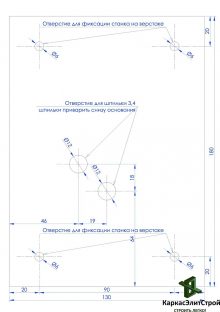
Machine base

Machine hinge

General view of the machine
Alternative ways of working with valves
If you are still going to professionally make various metal structures on your own, then it is worth advising you to purchase an inexpensive factory-made machine, which will have a lot of useful devices in its design. Typically, these machines operate on an electric drive and have:
- moving part,
- several shafts,
- double-sided stops.
You can see how such a factory one works in this video.
But in order to fully understand the physics of the processes taking place and prevent marriage in your work with a different metal profile, the following table will come in handy:
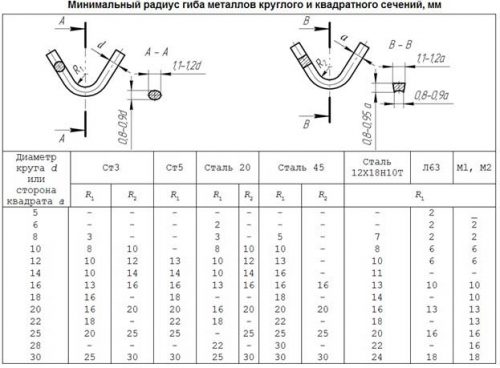
Table of minimum bending radii of reinforcement, bar and round timber
